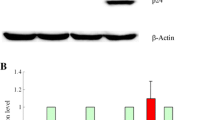Abstract
The recent discovery of HIV-1 genome-encoded novel microRNA (miRNA; designated as hiv1-mir-H1) having ability to target selectively and specifically human cellular AATF gene, prompted us to explore the role of this miRNA in the regulation of genes involved in cellular apoptosis, proliferation and nucleic acid-based immune mechanism governed by miRNAs. Such a study revealed that this miRNA-induced knockdown of AATF gene, within normal human blood mononuclear cells, was responsible for the suppression of genes coding for Bcl-2, c-myc, Par-4 and Dicer. Further, hiv1-mir-H1 had the capacity to downregulate expression of cellular miR149 gene recognized to target Vpr gene encoded by HIV-1. Based upon these findings, we propose an “Epigenomic Pathway” through which hiv1-mir-H1 induced AATF gene knockdown within human mononuclear cells initiates their apoptosis.







Similar content being viewed by others
References
Hariharan M, Scaria V, Pillai B, Brahmachari SK (2005) Targets for human encoded microRNAs in HIV genes. Biochem Biophys Res Commun 337:1214–1218. doi:10.1016/j.bbrc.2005.09.183
Kaul D, Khanna A, Suman (2006) Evidence and nature of a novel miRNA encoded by HIV-1. Proc Indian Natl Sci Acad 72:91–95
Bartel DP (2004) MicroRNAs: genomics, biogenesis, mechanism and function. Cell 116:281–297. doi:10.1016/S0092-8674(04)00045-5
Page G, Lodige I, Kogel D, Scheidtmann HK (1999) AATF, a novel transcription factor that interacts with Dlk/ZIP kinase and interferes with apoptosis. FEBS Lett 462:187–191. doi:10.1016/S0014-5793(99)01529-X
Monaco L, Passananti C, Fanciulli M (2003) Genomic structure and transcriptional regulation of Che-1 a novel partner of Rb. Gene 321:57–63. doi:10.1016/S0378-1119(03)00834-5
Cheema SK, Mishra SK, Rangnekar VM, Tari AM, Kumar R, Berestin GL (2003) Par-4 transcriptionally regulates Bcl-2 through a WT1-binding site on the bcl-2 promoter. J Biol Chem 278:19995–20005. doi:10.1074/jbc.M205865200
Kruman II, Nath A, Maragos WF, Chan SL, Jones M, Rangnekar VM, Jakel RJ, Mattson MP (1999) Evidence that Par-4 participates in the pathogenesis of HIV Encephalitis. Am J Pathol 155:39–46
Kaul D, Mehrotra A (2007) Functional characterization of AATF transcriptome in human leukemic cells. Mol Cell Biochem 297:215–220. doi:10.1007/s11010-006-9317-1
Triboulet R, Mari B, Lin YL, Chable-Bessia C, Bennasser Y, Lebrigand K, Cardinaud B, Maurin T, Barbry P, Baillat V et al (2007) Suppression of miRNA-silencing pathway by HIV-1 during virus replication. Science 315:1579–1582. doi:10.1126/science.1136319
Pfeffer S, Sewer A, Lagos-Quintana M, Sheridan R, Sander C, Grasser FA, van Dyk LF, Ho CK, Shuman S, Chien M et al (2005) Identification of microRNAs of the herpesvirus family. Nat Methods 2:269–276. doi:10.1038/nmeth746
Omoto S, Ito M, Tsutsumi Y, Ichikawa Y, Okuyama H, Brisible EA, Saksena NK, Fujii YR (2004) HIV-1 nef suppression by virally encoded microRNA. Retrovirology 1:44. doi:10.1186/1742-4690-1-44
Bennasser Y, Le SY, Benkirane M, Jeang KT (2005) Evidence that HIV-1 encodes an siRNA and a suppressor of RNA silencing. Immunity 22:607–619. doi:10.1016/j.immuni.2005.03.010
Ouellet DL, Plante I, Landry P, Barat C, Janelle M, Flamand L, Trembley MJ, Provost P (2008) Identification of functional microRNAs released through asymmetrical processing of HIV-1 TAR element. Nucleic Acids Res 36:2353–2365. doi:10.1093/nar/gkn076
Kloosterman WP, Steiner FA, Berezikov E, de Bruijin E, van de Bett J, Verheul M, Cuppen E, Plasterk RH (2006) Cloning and expression of new microRNAs from zebrafish. Nucleic Acids Res 35:2558–2569. doi:10.1093/nar/gkl278
Zhao RY, Bukrinsk M, Elder RT (2005) HIV-1 viral protein R (Vpr) & host cellular responses. Indian J Med Res 121:270–286
Kino T, Gragerov A, Slobodskaya O, Tsopanomichalou M, Chrousos GP, Pavlakis GN (2002) Human immunodeficiency virus type I (HIV-1) accessory protein Vpr induces transcription of the HIV-1 and glucocorticoid-responsive promoters by binding directly to p300/CBP co-activators. J Virol 76:9724–9734. doi:10.1128/JVI.76.19.9724-9734.2002
Felzien LK, Woffendin C, Hottiger MO, Subbramanian RA, Cohen EA, Nabel GJ (1998) HIV transcriptional activation by the accessory protein, VPR, is mediated by the p300 co-activator. Proc Natl Acad Sci USA 95:5281–5286. doi:10.1073/pnas.95.9.5281
Leister P, Burgdorf S, Scheidtmann KH (2003) Apoptosis antagonizing transcription factor AATF is a novel co-activator of nuclear hormone receptors. Signal Transduct 3:17–25. doi:10.1002/sita.200300020
Burgdorf S, Leister P, Scheidtmann KH (2004) TSG101 interacts with apoptosis-antagonizing transcription factor and enhances androgen receptor-mediated transcription by promoting its monoubiquitination. J Biol Chem 279:17524–17534
Author information
Authors and Affiliations
Corresponding author
Rights and permissions
About this article
Cite this article
Kaul, D., Ahlawat, A. & Gupta, S.D. HIV-1 genome-encoded hiv1-mir-H1 impairs cellular responses to infection. Mol Cell Biochem 323, 143–148 (2009). https://doi.org/10.1007/s11010-008-9973-4
Received:
Accepted:
Published:
Issue Date:
DOI: https://doi.org/10.1007/s11010-008-9973-4




